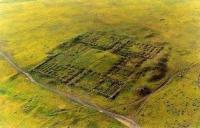You are here
Ancient settlement Tas-Akyr.

Traveling in Kazakhstan.
"Miracles and wonders! Pass on!"
Ray Bradbury.
Ancient fortifications of Kazakhstan.
Studies have shown that Tas-Akyr is the ruins of an unfinished feudal palace-castle located on the side of a mountain. Thus, he dominates the surrounding area in a radius of about 25-30 km. The northern facade opened onto a wide valley extending into the steppe; the south was facing a mountain range; the eastern and western facades were in contact with hills scattered on the slopes of a high mountain range. In plan it consists of a complex of residential, office and utility rooms, grouped around a vast courtyard.
The premises in the back of the courtyard (at the southern entrance) represented the owner’s chambers and the living room. The rooms at the northern entrance were most likely intended for guards with attendants and a stable for the stable (rooms, common room and stalls).
The central courtyard with a pond could simultaneously serve as a springboard for the serf troops, a gathering place for people, the announcement of official orders or religious ceremonies. Another similar structure made of stone, but on a scale much smaller than Tas-Akyr, lies in ruins on the border of Kazakhstan with Karakalpakia.
This building is Beleuli. Beleuli is hardly a caravanserai; most likely it is a military fortress, part of the system of stone towers located in Ustyurt (between Ustyurt and Urgench). Popular legends speak in favor of this assumption: legends about the giant builders Tas-Akyr and Beleuli.
The name "Tas-Akyr" in Kazakh means "stone nursery", where the pet food is placed. The fact is that the stone blocks from which this structure was built have the appearance of such a manger. Currently, there are only traces of unfinished walls with dimensions of 150,160,146 and 140 m in plan.
The presence of towers that we discovered in 1953 at the two corners of the northern facade of Tas-Akyr once again confirms the correct dating of this structure from the 7th to 8th centuries. From the decor of this monument, only a fragment of a geometric ornament on a stone is known (carving).
The beginning of the construction of Tas-Akyr, apparently, dates back to the time before the decisive battle between the Arab and Chinese forces, which occurred in the Talas Valley in 751 BC. e. After this event, the castle remained forever unfinished.
The boldness of the plan, the grandeur of the scale and the extraordinary amount of material resources and labor resources, with which the sovereign began to build this magnificent building, amazes. How many centuries, individual vandals of the human race pulled these stones away and how many of them remained in these ruins.
In 1953, here, at a depth of more than 2 m, under the foundation, we discovered a part of a metal tool, which, apparently, was used for cultivating the earth. A detailed study of the remains of masonry walls showed that some of the stones were laid on a ganch solution, which indicates the use of ganch already in the VIIth - VIIIth centuries.
The walls of Tas-Akyr are made up of large blocks with dimensions of 140 x 70 x 70 (80 cm), which indicates the desire of the architect to introduce a completely new building material and new methods of work in construction. The architect sought to facilitate the construction, for which they used trough-like recesses in stone blocks.
These facts testify to the freshness of architectural thought and the courage of daring, which gave rise to the beginnings of large-block construction in those days. The study of Tas-Akyr is not yet completed, but each time new data obtained deepen our knowledge of the architectural monument.
Enrich us with materials clarifying our ideas about the development of building art in Kazakhstan.
Authority:
Margulan A. Kh., Basenov T., Mendikulov M. “Architecture of Kazakhstan”. Alma-Ata, 1959, pp. 94 - 96.







